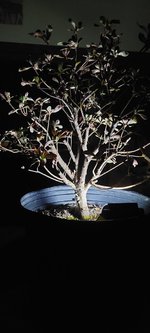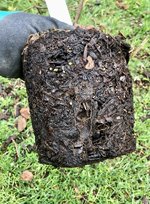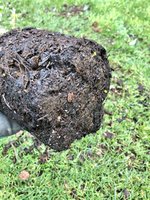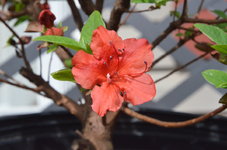You are using an out of date browser. It may not display this or other websites correctly.
You should upgrade or use an alternative browser.
You should upgrade or use an alternative browser.
My 1st Azalea is a semi-evergreen. Bronzed leaves, now what?
- Thread starter Japonicus
- Start date
Deep Sea Diver
Masterpiece
Gosh, just root washed a nursery satsuki this morning, but didn’t take any photos...
In any event, the rootball looks in good shape. There is a bit of black in the center that can be teased out a replaced by small bark/peat and perlite. Appears to be broken down soil. Precautionary. No worries then until things get better up top.
I would repot next spring. I use a Kanuma blend because root rot is not an issue, maintenance is easy and it’s near impossible to overwater if one has good drainage. Yet there are many different medias that can work for azaleas.
Actually finishing cuts are smooth and convex, mimicking the surface of the tree… for small trees like yours. Big trees are a bit different story. Azaleas have exceedingly thin bark, so a concave cut will heal with a dimple.
In this situation I’d carefully nip off the stubs to above the surface, then smooth the rest off with a sharp chisel, grafting knife etc. The wood is surprising hard. You can leave a slight smooth bumps as this will add some suble gnarly realism as the tree ages. I use putty to seal most cuts larger then a pencil eraser. Mold smooth past the edges a bit more then other trees.
cheers
DSD sends
In any event, the rootball looks in good shape. There is a bit of black in the center that can be teased out a replaced by small bark/peat and perlite. Appears to be broken down soil. Precautionary. No worries then until things get better up top.
I would repot next spring. I use a Kanuma blend because root rot is not an issue, maintenance is easy and it’s near impossible to overwater if one has good drainage. Yet there are many different medias that can work for azaleas.
Actually finishing cuts are smooth and convex, mimicking the surface of the tree… for small trees like yours. Big trees are a bit different story. Azaleas have exceedingly thin bark, so a concave cut will heal with a dimple.
In this situation I’d carefully nip off the stubs to above the surface, then smooth the rest off with a sharp chisel, grafting knife etc. The wood is surprising hard. You can leave a slight smooth bumps as this will add some suble gnarly realism as the tree ages. I use putty to seal most cuts larger then a pencil eraser. Mold smooth past the edges a bit more then other trees.
cheers
DSD sends
Deep Sea Diver
Masterpiece
Japonicus
Masterpiece
Yeh that looks a bit mucky, and what I was on the look out for.Here’s my last 1 gal nursery potted azalea for the year
It’s a bit wet… it’s in the greenhouse with all the kanuma based azaleas and they are watered pretty much with impunity that why it’s going into kanuma blend… but similar to yours, except not as root bound.
Cheers
DSD sends
View attachment 428342
View attachment 428343
Don't think this hot shot is pot bound. There's a mat of roots on the bottom
but the sides are like I could just squeeze it in my hands and remove most of the soil
with no tools, with a bit of wiggling through. I think you cautioned against repot normally,
but I'm not clear on the darker "black" spot removal and refresh now or when it's recovered.
It could just be the picture, but I really didn't see anything that looked askew,
other than the roots are so fine. Then thanks for posting your pics un potted and the fine root system.
Surely the roots are more coarse in the crown. There's nothing in the fine roots to give purchase
to secure in a pot, so I bet the roots become more coarse as you go into the crown.
I appreciate your coaching DSD.
Japonicus
Masterpiece
Last May
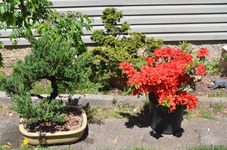
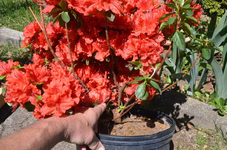

 www.bonsainut.com
www.bonsainut.com
This was when I selected the azalea. Wasn't shopping for one, but when I started looking at the structure underneath
the blooms, it appeared to me that it would make a decent bonsai if I could manage to keep it alive
and give it good direction. $35 for 3 gallon and a proven bloomer, thought it just made sense to try my hand at it.
I was really planning on potting it up this Spring until I find out it's not a true deciduous and the leaves were
so brown and falling. I would have used my standard conifer blend which includes 1 part bark.
Lava, Monto Clay (Turface), pumice and bark blend.



Girards Hot Shot azalea
This is my 1st go at a flowering shrub, other than a crabapple tree, so no experience in bonsai with this. Pics taken May 1st 2021
This was when I selected the azalea. Wasn't shopping for one, but when I started looking at the structure underneath
the blooms, it appeared to me that it would make a decent bonsai if I could manage to keep it alive
and give it good direction. $35 for 3 gallon and a proven bloomer, thought it just made sense to try my hand at it.
I was really planning on potting it up this Spring until I find out it's not a true deciduous and the leaves were
so brown and falling. I would have used my standard conifer blend which includes 1 part bark.
Lava, Monto Clay (Turface), pumice and bark blend.
Deep Sea Diver
Masterpiece
You are most welcome!
The photo showed what looked like a dark spot in the bottom core area. Darker then the outside area. This could be just the photo quality. Likely things are all a-ok.
I’m not a good judge of azalea media other then the ones I’ve used. I did a survey on the types of azalea media folks used at BN a couple years ago. There were over 20 medias used and everyone I contacted thought theirs was the best for azalea. No one did a side by side comparison. So your tree, your choice. No judging.
Future information to tuck away gathered after over 100 nursery azalea root washes.
Azalea roots slowly thicken on the very top and taper quickly as they leave the top 1”.
Azaleas root balls and pot feel can be deceiving, especially when one side of the roots go down and not the other.
The Komo Kulshan shown earlier today had a very solid feel and thick root ball.
First chopstick and root wash. Note root form. Thin down to the bottom. Look at the upper right side. Roots do not look the same. These roots are not healthy, likely dead. Further investigation…
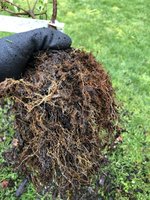
Second round. The right side roots are washing away... Indicating these roots are not healthy.
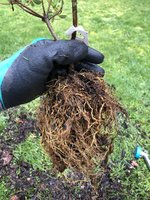
Final of six rounds. Note the weak area on the right side. The roots were dying back to the base. Trimmed to viable root.
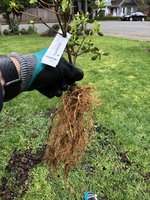
So until I take a real look under the hood, I never really know for sure how things are going.
Looking forward to seeing your tree bursting with health!
cheers
DSD sends
The photo showed what looked like a dark spot in the bottom core area. Darker then the outside area. This could be just the photo quality. Likely things are all a-ok.
I’m not a good judge of azalea media other then the ones I’ve used. I did a survey on the types of azalea media folks used at BN a couple years ago. There were over 20 medias used and everyone I contacted thought theirs was the best for azalea. No one did a side by side comparison. So your tree, your choice. No judging.
Future information to tuck away gathered after over 100 nursery azalea root washes.
Azalea roots slowly thicken on the very top and taper quickly as they leave the top 1”.
Azaleas root balls and pot feel can be deceiving, especially when one side of the roots go down and not the other.
The Komo Kulshan shown earlier today had a very solid feel and thick root ball.
First chopstick and root wash. Note root form. Thin down to the bottom. Look at the upper right side. Roots do not look the same. These roots are not healthy, likely dead. Further investigation…

Second round. The right side roots are washing away... Indicating these roots are not healthy.

Final of six rounds. Note the weak area on the right side. The roots were dying back to the base. Trimmed to viable root.

So until I take a real look under the hood, I never really know for sure how things are going.
Looking forward to seeing your tree bursting with health!
cheers
DSD sends
Japonicus
Masterpiece
Deep Sea Diver
Masterpiece
That’s the ticket!
cheers
DSD sends
cheers
DSD sends
shinmai
Chumono
That is a dramatic improvement from where it was when you got it. I’m not personally a big fan of Miracid—it’s a 30/10/10 blend, and all that nitrogen will give you some long internodes. That’s already a problem with many Girard hybrids, especially Pleasant White. I have had some success over the last year with a liquid, kelp-based fertilizer called “Watch Us Grow”. Made in Sturgeon Bay, Wisconsin, and $26 a gallon from Amazon. It’s. 10-10-10, with significant amounts of chelated copper, zinc, and magnesium. One tablespoon per gallon of water, once every week or two.
From a design perspective you will eventually have to address the place where the trunk divides into multiple branches. Domestic hybrids are notorious for developing reverse taper or outrIght bulge where more than two branches originate. Especially if you buy an older example that has been up-potted, you’ll see places where the multiple shoots from a blossom have become branches, usually in a cluster of five. Those branches will be 1/2” or so, pretty much unbendable, and straight and un-tapered like a soda straw. The good news is you can amputate the daylights out of them, and they will quickly provide you with new shoots. I have a Girard’s Hot Shot with that problem, which will be undergoing a multiple branch-ectomy after it blooms. It has nice nebari. And a beautiful curving sweep from the soil up to that five-branch intersection. Fortunately one branch will lend itself to being the natural leader.
Good luck with this one—it’s going to be gorgeous when it blooms.
From a design perspective you will eventually have to address the place where the trunk divides into multiple branches. Domestic hybrids are notorious for developing reverse taper or outrIght bulge where more than two branches originate. Especially if you buy an older example that has been up-potted, you’ll see places where the multiple shoots from a blossom have become branches, usually in a cluster of five. Those branches will be 1/2” or so, pretty much unbendable, and straight and un-tapered like a soda straw. The good news is you can amputate the daylights out of them, and they will quickly provide you with new shoots. I have a Girard’s Hot Shot with that problem, which will be undergoing a multiple branch-ectomy after it blooms. It has nice nebari. And a beautiful curving sweep from the soil up to that five-branch intersection. Fortunately one branch will lend itself to being the natural leader.
Good luck with this one—it’s going to be gorgeous when it blooms.
Japonicus
Masterpiece
Good input. It was super healthy when I got it though. The poor health is due to unprotected Winter and excellentThat is a dramatic improvement from where it was when you got it. I’m not personally a big fan of Miracid—it’s a 30/10/10 blend, and all that nitrogen will give you some long internodes. That’s already a problem with many Girard hybrids, especially Pleasant White. I have had some success over the last year with a liquid, kelp-based fertilizer called “Watch Us Grow”. Made in Sturgeon Bay, Wisconsin, and $26 a gallon from Amazon. It’s. 10-10-10, with significant amounts of chelated copper, zinc, and magnesium. One tablespoon per gallon of water, once every week or two.
From a design perspective you will eventually have to address the place where the trunk divides into multiple branches. Domestic hybrids are notorious for developing reverse taper or outrIght bulge where more than two branches originate. Especially if you buy an older example that has been up-potted, you’ll see places where the multiple shoots from a blossom have become branches, usually in a cluster of five. Those branches will be 1/2” or so, pretty much unbendable, and straight and un-tapered like a soda straw. The good news is you can amputate the daylights out of them, and they will quickly provide you with new shoots. I have a Girard’s Hot Shot with that problem, which will be undergoing a multiple branch-ectomy after it blooms. It has nice nebari. And a beautiful curving sweep from the soil up to that five-branch intersection. Fortunately one branch will lend itself to being the natural leader.
Good luck with this one—it’s going to be gorgeous when it blooms.
Sun exposure for a conifer. Thanks to @Deep Sea Diver I got the idea to place it where my JM in ground thrive,
on the East side of my home.
Thanks for the check on the fertiliser situation. With the blooms about, is what made me reach for the
MiracleGro MirAcid. Perhaps Bloom Booster would've been a better call, but I don't recall the analysis ATM.
Yes I have been eyeballing that juncture/crotch with that bit of reverse taper or swelling taking place, even this afternoon.
I have an idea on 2 branches that could go, but surely not this year with the recent poor health?
Maybe I could keep a couple branches in check without fully removing? I mean I had planned to pot it up
this year, but that couldn't happen, so next year in Kanuma or continue holding off for more health?
Japonicus
Masterpiece
If you notice...That’s the ticket!
cheers
DSD sends
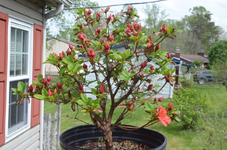
(we're facing E. here) ...there's a fence about 5' the other side of our home here.
It runs N to the back of the property. This cuts out early morning Sun, but with the
azalea back only a few feet from the corner, it probably gets Sun from 11 am for maybe 3 hrs.
IDK just a guestimate. My Wilsons Pink is back maybe 12-14' and is doing amazing.
They don't like a lot of Sun IIRC. Katsura and Mikawa Yatsabusa also doing fantastic there.
Deep Sea Diver
Masterpiece
Looks great! Glad you are thinking about styling. @Shibui is spot on. The most pernicious thing about azaleas is their tend to create wheel spoke hubs at each flower site.
Not sure you can’t do some preliminary styling moves after flowering is done and before the new branchlets push out a lot. One way to do this is to cut some or all of the branches you are planning to remove halfway or a third of the way through (and cut paste). This will keep the flow partially intact, but redistribute energy to the other parts of the tree. Please be sure to leave green growth outwards from the cut to keep the flow going up the branch.
As stated before, another issue is that some landscape cultivars always want to create longish internodes. Doesn’t make much difference what ferts I use imho, cultivars with this attribute seem genetically programmed to push hard between flowering sites. The R, Kuiusianum native, a dwarf used in some breeding regimes, does this too. The best way I found to alleviate this situation is to cut back as far as possible on each branch, while still leaving green growth near the cut end. This usually causes multiple budding down the remaining branch. Then it’s a matter of selecting where to cut back too next. Not sure this works in every case, but so far I’ve had good success.
Anyways cutting back is never a lot of fun for me! When I do there is a distinct tendency to go all out. This can be a blessing or a fault.
Congratulations again.
cheers
DSD sends
Not sure you can’t do some preliminary styling moves after flowering is done and before the new branchlets push out a lot. One way to do this is to cut some or all of the branches you are planning to remove halfway or a third of the way through (and cut paste). This will keep the flow partially intact, but redistribute energy to the other parts of the tree. Please be sure to leave green growth outwards from the cut to keep the flow going up the branch.
As stated before, another issue is that some landscape cultivars always want to create longish internodes. Doesn’t make much difference what ferts I use imho, cultivars with this attribute seem genetically programmed to push hard between flowering sites. The R, Kuiusianum native, a dwarf used in some breeding regimes, does this too. The best way I found to alleviate this situation is to cut back as far as possible on each branch, while still leaving green growth near the cut end. This usually causes multiple budding down the remaining branch. Then it’s a matter of selecting where to cut back too next. Not sure this works in every case, but so far I’ve had good success.
Anyways cutting back is never a lot of fun for me! When I do there is a distinct tendency to go all out. This can be a blessing or a fault.
Congratulations again.
cheers
DSD sends
shinmai
Chumono
My wife has threatened to enroll me in a twelve-step program for compulsive pruners.
Japonicus
Masterpiece
Speaking of branch selection, is this preliminary styling move performed at the trunk shoulderOne way to do this is to cut some or all of the branches you are planning to remove halfway or a third of the way through (and cut paste).
and if so is it best to cut from the top or side to avoid the lifeline?
another issue is ... longish internodes.
Your English is fine, unfortunately I'm not following.The best way I found to alleviate this situation is to cut back as far as possible on each branch, while still leaving green growth near the cut end.
Could you rephrase this as it is a process I've never carried out and I want to
make sure I'm following you correctly, and when it is time for this particular project.
Thanks for you helps DSD
Japonicus
Masterpiece
This will be the ugliest leafed bloomer you've ever seen this year.
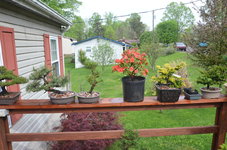

It's been raining all day off and on, so pretty damp here, but I had high hopes to get this into a pot of sorts
along with some of these others that got potted or repotted the Spring. Next year I guess.
Is there a good guideline for pot height for a 1st move, or like anything else, you don't know
until uncovered?
Deep Sea Diver
Masterpiece
Young azaleas one can pretty much cut off branches at will without regard of the lifeline. A better way as trees get older is to respect the lifeline (sap flow) and leave a small amount of foliage on the end. This will reduce and reroute the flow, then cut after a season... or two
It is also a way to reliably get a branch to backbud compared to cutting off all growth and expecting the bare branch to back bud… a much higher percentage of success for the former method.
To reliably keep flow for even older azaleas and the resultant backbudding is in the spring to take a notch off the top of the branch 1/3 to 1/2 way through, close to the shoulder. Then reduce the branch leaving a smal amount of foliage to keep the flow, albeit reduced, going up the branch…so the flow gets rerouted in the trunk. Then take the remainder off in the fall…. And cut smooth back to the trunk and past.
I’ve seen this done over a year and more also, not sure what the exact decision boundary is. Sometimes different cultivars are known to resent severe cutbacks.
Really old azaleas are much more sensitive to severe cut backs of older branches disrupting the flow up the trunk. Both Callahan and Watanabe write about this, even approach grafting a branch right above the branch to help reroute the flow up the trunk.
Hope that helps
Cheers
DSD sends
It is also a way to reliably get a branch to backbud compared to cutting off all growth and expecting the bare branch to back bud… a much higher percentage of success for the former method.
To reliably keep flow for even older azaleas and the resultant backbudding is in the spring to take a notch off the top of the branch 1/3 to 1/2 way through, close to the shoulder. Then reduce the branch leaving a smal amount of foliage to keep the flow, albeit reduced, going up the branch…so the flow gets rerouted in the trunk. Then take the remainder off in the fall…. And cut smooth back to the trunk and past.
I’ve seen this done over a year and more also, not sure what the exact decision boundary is. Sometimes different cultivars are known to resent severe cutbacks.
Really old azaleas are much more sensitive to severe cut backs of older branches disrupting the flow up the trunk. Both Callahan and Watanabe write about this, even approach grafting a branch right above the branch to help reroute the flow up the trunk.
Hope that helps
Cheers
DSD sends
Japonicus
Masterpiece
Yes cutting near the shoulder and on top, thanks for that clarification.Young azaleas one can pretty much cut off branches at will without regard of the lifeline. A better way as trees get older is to respect the lifeline (sap flow) and leave a small amount of foliage on the end. This will reduce and reroute the flow, then cut after a season... or two
It is also a way to reliably get a branch to backbud compared to cutting off all growth and expecting the bare branch to back bud… a much higher percentage of success for the former method.
To reliably keep flow for even older azaleas and the resultant backbudding is in the spring to take a notch off the top of the branch 1/3 to 1/2 way through, close to the shoulder. Then reduce the branch leaving a smal amount of foliage to keep the flow, albeit reduced, going up the branch…so the flow gets rerouted in the trunk. Then take the remainder off in the fall…. And cut smooth back to the trunk and past.
I’ve seen this done over a year and more also, not sure what the exact decision boundary is. Sometimes different cultivars are known to resent severe cutbacks.
Really old azaleas are much more sensitive to severe cut backs of older branches disrupting the flow up the trunk. Both Callahan and Watanabe write about this, even approach grafting a branch right above the branch to help reroute the flow up the trunk.
Hope that helps
Cheers
DSD sends
Reducing foliage in the mid of the branch also helps clarify.
However that is one of 2 separate tasks and I think what threw me off is that this
action is carried out BOTH, one for selection + removal, and one to shorten internode length
or at least creating back budding. Your mention of "another issue" with landscape cultivars
being internode length, and how you dealt with that, I thought you were proposing
a 2nd method, for a 2nd issue, yet it is the same it appears, and that's what was throwing me off.
Am I following correctly?
Deep Sea Diver
Masterpiece
Yes, by Jove, I believe we’ve got it, 
I hope this advice works for you. Azaleas can be remarkable resilient if handled properlyand I think you are approaching this process
from the right direction.
cheers
DSD sends
I hope this advice works for you. Azaleas can be remarkable resilient if handled properlyand I think you are approaching this process
from the right direction.
cheers
DSD sends
Japonicus
Masterpiece
I did some pruning today and removed spent flowers.
Some diseased leaves and 2 or 3 insects. Recently received some Amdro granules while treating lawn.
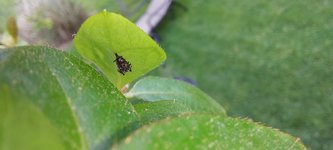
This guy was dust in the wind basically. Drifted away when i attempted to smash it.
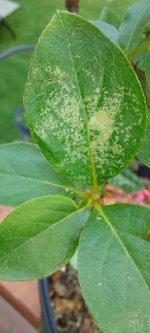

Top and underside of leaf.
Will Mancozeb work or Daconil?
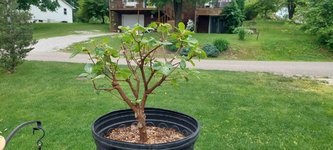
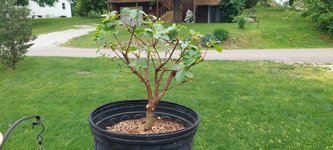
What else should i be doing?

This was after i removed a couple branches at or near the crotch.
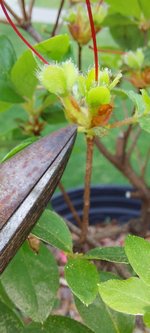

Some diseased leaves and 2 or 3 insects. Recently received some Amdro granules while treating lawn.

This guy was dust in the wind basically. Drifted away when i attempted to smash it.


Top and underside of leaf.
Will Mancozeb work or Daconil?


What else should i be doing?

This was after i removed a couple branches at or near the crotch.


Deep Sea Diver
Masterpiece
Ugh…fraz. Looks like the beginning of a Lace bug Issue.
Azaleas in full sun get attacked the worst. See our Purple Splendor azalea in 2019

I use imidicloprid right after bloom to stop them and prevent killing off bees if this shows up now we have a lot of azaleas. It’s ok to use then. There is also a 12 month effective drench of the same chemical, but no…
btw both Mancozeb and Daconil are fungicides. So no go.
Other options: Spray all sides of foliage forcefully weekly. Safer soap, spray all surfaces. Repeat each week. It works.. if it doesn’t rain mid week.. Lady bugs, Assassian bugs, Lacewings… all these guys have wings and use them..
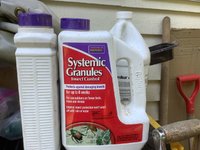
If you only have a couple azaleas I recommend you try the latter methods.
Best
DSD sends
Azaleas in full sun get attacked the worst. See our Purple Splendor azalea in 2019

I use imidicloprid right after bloom to stop them and prevent killing off bees if this shows up now we have a lot of azaleas. It’s ok to use then. There is also a 12 month effective drench of the same chemical, but no…
btw both Mancozeb and Daconil are fungicides. So no go.
Other options: Spray all sides of foliage forcefully weekly. Safer soap, spray all surfaces. Repeat each week. It works.. if it doesn’t rain mid week.. Lady bugs, Assassian bugs, Lacewings… all these guys have wings and use them..

If you only have a couple azaleas I recommend you try the latter methods.
Best
DSD sends
Similar threads
- Replies
- 3
- Views
- 481
- Replies
- 22
- Views
- 1K


